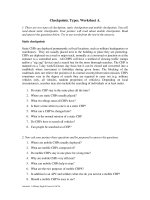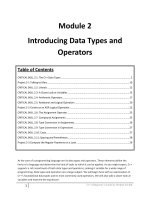Checkpoints. Types. Worksheet A
Bạn đang xem bản rút gọn của tài liệu. Xem và tải ngay bản đầy đủ của tài liệu tại đây (92.65 KB, 12 trang )
Checkpoints. Types. Worksheet A.
1. There are two types of checkpoint, static checkpoints and mobile checkpoints. You will
read about static checkpoints. Your partner will read about mobile checkpoints. Read
and answer the questions below. Try to use words from the text in the answers.
Static checkpoints
Static CHPs are deployed permanently at fixed locations, such as military headquarters or
warehouses. They are usually placed next to the building or place they are protecting.
CHPs are deployed on a road or major track, normally at a crossroad or junction or at the
entrance to a controlled area. All CHPS will have a method of slowing traffic (ramps
and/or a “zig zag” device) and a search bay for the more thorough searches. The CHP is
manned on a 7-day week/24-hours day basis but it can be closed and converted into a
roadblock where movement is forbidden during given hours. The blocking of the
road/track does not relieve the position of its normal security/observation mission. CHPs
sometimes vary in the degree of search they are required to carry out (e.g. military
vehicles only, all vehicles, random proportion of vehicles). Depending on local
circumstances, searches may also include the searching of individuals or at least males.
1. Do static CHP stay in the same place all the time?
2. Where are static CHPs usually placed?
3. What two things must all CHPs have?
4. Is there a time when no-one is at a static CHP?
5. What can a CHP be changed into?
6. What is the normal mission of a static CHP
7. Do CHPs have to search all vehicles?
8. Can people be searched at a CHP?
2. Now ask your partner these questions and be prepared to answer his questions.
1. Where are mobile CHPs usually deployed?
2. What are mobile CHPs composed of?
3. Do mobile CHPs stay in one place for a long time?
4. Why are mobile CHPs very efficient?
5. What can mobile CHPs help to stop?
6. What are the two purposes of mobile CHPS?
7. In addition to an APC and soldiers what else do you need at a mobile CHP?
8. Should a mobile CHP be easy to see?
Attention! A Military English Course for NCOs
Checkpoints. Types. Worksheet B.
There are two types of checkpoint, static checkpoints and mobile checkpoints. You will
read about mobile checkpoints. Your partner will read about static checkpoints. Read
and answer the questions below. Try to use words from the text in the answers.
Mobile checkpoints
Mobile CHPs are deployed where the PKO has difficulties covering all roads and tracks
with static CHPs. Mobile CHPs will be composed of a minimum of one section in two
armoured vehicles. This group will leave base, operate over a given road/track net- work
and set up “snap CHPs” en route for short periods. Mobile CHPs can often be very
efficient, because no one knows in advance where they are temporarily being set up. This
could help to prevent smuggling of weapons and explosives. The purpose of a mobile
CHP is to reinforce control and make smuggling/infiltration more difficult. A temporary
mobile CHP would normally consist of a vehicle or an APC, with some concertina wire,
CHPs signs and personnel. To control a narrow path, you need 3-6 soldiers. Pick out a
concealed position, so that the CHP is a surprise to the people approaching.
9. Where are mobile CHPs usually deployed?
10. What are mobile CHPs composed of?
11. Do mobile CHPs stay in one place for a long time?
12. Why are mobile CHPs very efficient?
13. What can mobile CHPs help to stop?
14. What are the two purposes of mobile CHPS?
15. In addition to an APC and soldiers what else do you need at a mobile CHP?
16. Should a mobile CHP be easy to see?
2. Now ask your partner these questions and be prepared to answer his questions.
9. Do static CHP stay in the same place all the time?
10. Where are static CHPs usually placed?
11. What two things must all CHPs have?
12. Is there a time when no-one is at a static CHP?
13. What can a CHP be changed into?
14. What is the normal mission of a static CHP
15. Do CHPs have to search all vehicles?
16. Can people be searched at a CHP?
Attention! A Military English Course for NCOs
Checkpoints. Types. Answer Key
Mobile checkpoints
1. Where are mobile CHPs usually deployed? Where PKO can’t use static CHPS
2. What are mobile CHPs composed of? Minimum one section in two armoured
vehicles
3. Do mobile CHPs stay in one place for a long time? No, short periods
4. Why are mobile CHPs very efficient? No-one knows where they will be
5. What can mobile CHPs help to stop? Smuggling and infiltration
6. What are the two purposes of mobile CHPS? Reinforce control, prevent
smuggling
7. In addition to an APC and soldiers what else do you need at a mobile CHP? Signs
and concertina wire
8. Should a mobile CHP be easy to see? No, concealed position
Static checkpoints
1. Do static CHP stay in the same place all the time? Yes, permanently fixed
locations
2. Where are static CHPs usually placed? Next to a building or a junction
3. What two things must all CHPs have? Method of slowing traffic, search bay
4. Is there a time when no-one is at a static CHP? No,
5. What can a CHP be changed into? A roadblock
6. What is the normal mission of a static CHP? to provide security and to observe
7. Do CHPs have to search all vehicles? No, random proportion of cars
8. Can people be searched at a CHP? Yes
Vehicle Checkpoint. Rules and Equipment. Listening Text
So, I will tell you something about the rules and the equipment needed to operate a
UN Vehicle Checkpoint.
Let’s begin with how many soldiers are required. There should be a minimum of two
soldiers manning a checkpoint. Of course, the actual number used depends on traffic
and the general situation. If there is a lot of traffic and the situation is dangerous, then
you should have more soldiers.
What are the duties of these soldiers? Well, if there are only two soldiers, then one of
the soldiers checks people and vehicles. One soldier covers the area where the people
and the vehicles are checked. Now, you must remember. The soldier covering the area
must be armed and have easy access to a radio and telephone. If more soldiers are
manning the checkpoint, one of them could be ready to set up obstacles. These
obstacles cold stop vehicles trying to force their way through the CHP.
Oh, so that’s the number of soldiers used and their duties. What about the rules. Well,
the first and most important rule is that all radios, lights and equipment MUST
WORK PROPERLY and that all books, maps and files are ready for use.
Some things are not allowed in a checkpoint. There should be no private pictures on
the walls. Now photographs of young girls with almost no clothes on. And private
radios, cassette players and magazines are strictly forbidden. Got that. No radios,
cassette players or magazines.
Very important rule. All checkpoints are to be connected to their unit by radio AND
telephone line. In fact there should be a spare radio and batteries. It is important to
have a direct landline to ensure rapid coordination in urgent situations.
As for equipment; every soldier at a checkpoint should have the following personal
equipment. A proper uniform with a blue UN beret. A UN ID card. Their personal
weapon. A helmet and a flak jacket. Communication equipment. Personal First Aid
Kit.
There are many items that may be used to reinforce a CHP or OP. That is to make it
stronger. Here are some of them. Concertina wire, different types of bars and drums
for reducing speed, string with nails or similar gear to puncture the tyres of vehicles
Heavy concrete blocks (2 tons or heavier)
A vehicle checkpoint also needs lots of signs. There should be a UN sign, indicating
what kinds of personnel, weapons, uniforms, etc. are prohibited in the UN zone
Also, the access road should contain signs about 100 to 150 meters from the CHP at
both sides with text in English and local language:
YOU ARE NOW ENTERING (LEAVING) THE UN ZONE. REDUCE SPEED TO -
- MPH/KM/T. PLEASE HAVE YOUR ID-CARD READY. NO WEAPONS,
KNIVES OR EXPLOSIVES ARE ALLOWED IN THE UN ZONE.
Vehicle Checkpoints: Rules and Equipment: Worksheet.
1 You are going to listen to person talking about the rules that should be followed at a
Vehicle Checkpoint. Before you listen, look at the following questions and try to predict
the answers.
a) What is the minimum number of soldiers required to man a checkpoint?
b) What are the different duties of a soldier at a checkpoint?
c) What is the first and most important rule at a checkpoint?
d) What two ways are there of communicating between a checkpoint and
headquarters?
e) What personal equipment should a soldier have at a checkpoint?
f) What special equipment is needed to make a checkpoint effective?
2. Now listen and try to find the answers to those questions.
3. Work in pairs. Ask and answer the questions those six questions.
4. Listen again and fill in the gaps.
a) There should be a minimum of two soldiers ………………. a checkpoint.
b) If there are only two soldiers, then one of the soldiers ………. people and
vehicles.
c) One soldier ………… the area where the people and the vehicles are checked.
d) These obstacles could stop vehicles trying to ……….. their way through the CHP.
e) The first and most important rules is that all radios, lights and equipment
………………………………… .
f) And private radios, cassette players and magazines are …………………………..
g) It is important to have a direct landline to ensure ……………………………in
urgent situations.
5. Complete the following lists
Personal Equipment
……………………………………..
……………………………………..
……………………………………..
……………………………………..
……………………………………...
………………………………………
Special Checkpoint Equipment
………………………………………
…………………………………………
………………………………………...
…………………………………………..
………………………………………….
6. Now prepare a spoken briefing on the topic of Vehicle Checkpoints. Include
information about the purposes of checkpoints, the different types of checkpoints and
about manning, rules and equipment used at checkpoints.
Attention! A Military English Course for NCOs









